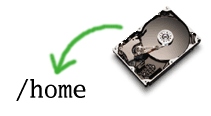|
|
![[Photo of the Author]](../../common/images/Guido-S.gif)
by Guido Socher (homepage) About the author: Guido likes Linux because of the community. It is a huge
project and somehow all the different people around the world
are working towards the same goal: Making it better every
day. |
The mystery of mount points
Abstract:
This article explains the concept of mount points but I hope
the article has also some information which is interesting to
readers who are not new to linux.
|
# df Filesystem 1K-blocks Used Available Use% Mounted on /dev/hda1 9070728 4701180 3908768 55% / /dev/hda3 24950428 683412 22999584 3% /home none 257236 0 257236 0% /dev/shm # mount /dev/hda1 on / type ext3 (rw) none on /proc type proc (rw) none on /dev/shm type tmpfs (rw) /dev/hda3 on /home type ext3 (rw) |
# fuser -m -u /mnt/usb /mnt/usb: 1347c(root) 1348c(guido) 1349c(guido)What you get from the fuser command is a list of processes still using the filesystem in question. Now you can check with "ps auxw" what this is or you can just kill them. After that umount will work.
drive u: file="/dev/sda1" # or sda4; some usb-stick have partition
# 4 created as factory default.
# dev mount point fs type flags /dev/sda1 /mnt/usb auto noauto,user 0 0This line means that sda1 (the first partition on the first scsi disk, usb storage disks are mapped to scsi disks) shall not be mounted automatically at startup (noauto) and can be mounted/umounted by anybody (user). The FS-type field is also set to auto so you can mount a usb-stick formatted with vfat or ext2 and the right filesystem will be detected automatically.
/home/guido -> ../home_nonet/guidoWhen user guido is on the network then he will see his normal home directory because the softlink is shaded out. When he is on the road then he will see /home_nonet/guido as his home directory (/home/guido).
|
Webpages maintained by the LinuxFocus Editor team
© Guido Socher "some rights reserved" see linuxfocus.org/license/ http://www.LinuxFocus.org |
Translation information:
|
2005-01-14, generated by lfparser_pdf version 2.51